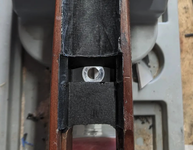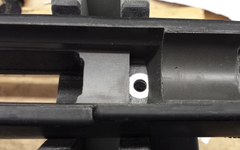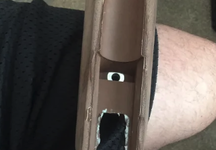That's a bummer! I was hoping you'd say you were speaking in generalities and didn't realize the Howa lug was relatively unique, so you had an out to walk back your claims.
For the same reason why you want to float the bottom of the lug on a traditionally oriented action while firmly supporting where the action screws insert, you want to float the bottom of the Howa action directly behind the lug while fully supporting where the action screws insert.
In any other way, you are creating a fulcrum, the action becomes the lever, and the action screws become battling loads that bend the action.
What a bummer I actually know what I’m talking about. lol
You aren’t wrong there being a lever, but the amount of force is not a lot. Action screws create how much clamping force at 60 inch pounds of torque? 1,400 lbs, 1,500 lbs? 1,500 lbs cantilevered less than 1/4” pulls up how hard on the rear action screw? 80 lbs ish? So the rear bedding is getting 1,420 lbs of clamping force while the front gets 1,500.
I don’t have a Howa, but the guys who wrote up their experiment with bedding or not on the Howa lug years ago convinced me it’s one of those things that is technically causing the receiver to be twisted, but as a practical matter it’s not enough to effect accuracy.
The amount of action flex is easy enough to measure. Attach a .0001” test indicator to the shank of the barrel and extend it back to read near the rear action screw as the front screw is loosened and tightened. I have no doubt it would move the needle. If only it made a difference on target I’d agree with you.
The whole argument goes away completely if an inch or two of the barrel shank is also bedded and removes the lever completely, as is often done. What would we talk about then?
Since the 1980s my test of bedding in a new rifle has been to slide a cereal box shim behind the front action screw - also creating a condition that should flex the action very similarly to the Howa. I’ve only seen identical accuracy between that and after the receiver is properly bedded.



